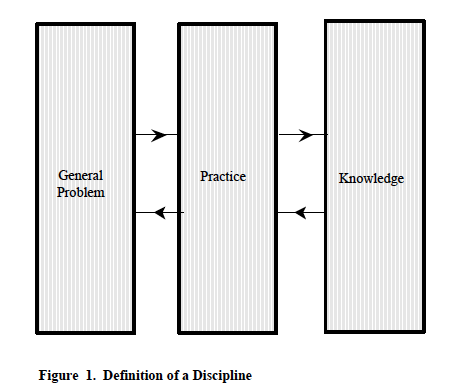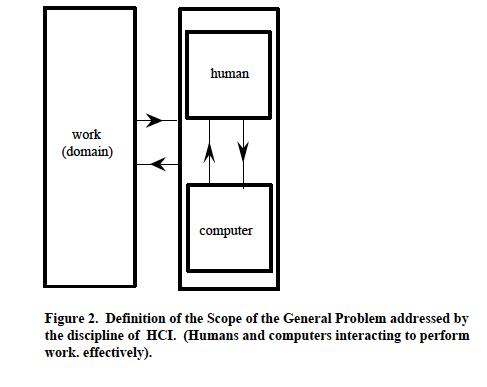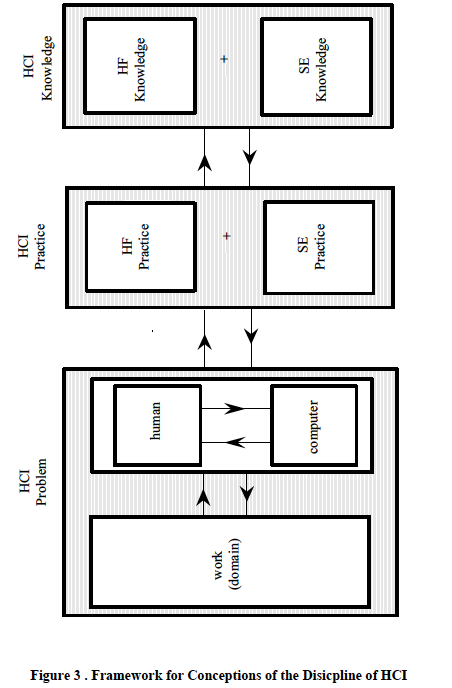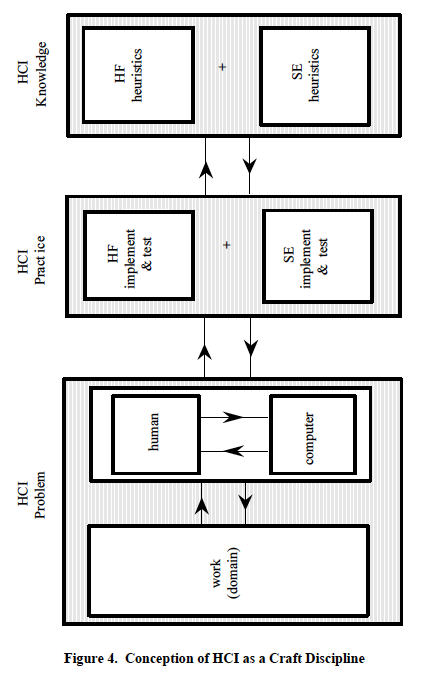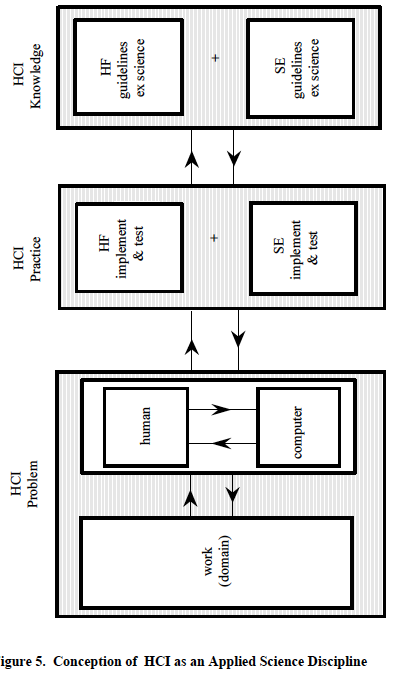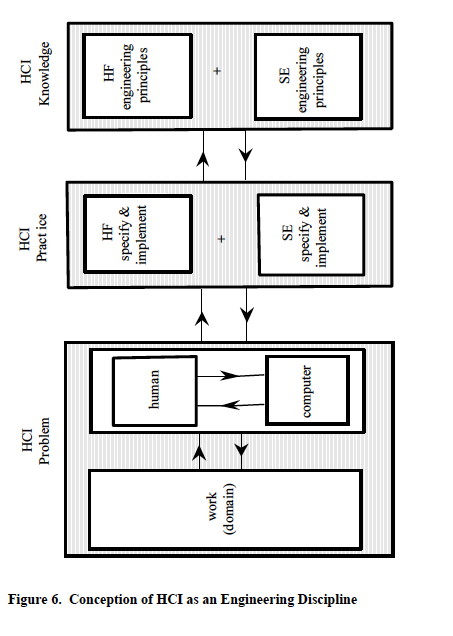4.4 Long and Dowell (1989) – HCI Engineering Practice – Short version
Conceptions for a Discipline of HCI: Craft, Applied Science and Engineering
John Long and John Dowell
…….. First, consideration of disciplines in general suggests their complete definition can be summarised as: ‘knowledge, practices and a general problem having a particular scope, where knowledge supports practices seeking solutions to the general problem’. Second, the scope of the general problem of HCI is defined by reference to humans, computers, and the work they perform. Third, by intersecting these two definitions, a framework is proposed within which different conceptions of the HCI discipline may be established, ordered, and related. The framework expresses the essential characteristics of the HCI discipline, and can be summarised as: ‘the use of HCI knowledge to support practices seeking solutions to the general problem of HCI’. ……..
Published in: People and Computers V. Sutcliffe A. and Macaulay L. (ed.s). Cambridge University Press, Cambridge. Proceedings of the Fifth Conference of the BCS HCI SIG, Nottingham 5-8 September 1989.
Contents
1. Introduction
1.1. Alternative Interpretations of the Theme
1.2. Alternative Conceptions of HCI: the Requirement for a Framework
1.3. Aims
2. A Framework for Conceptions of the HCI Discipline
2.1. On the Nature of Disciplines
2.2. Of Humans Interacting with Computers
2.3. The Framework for Conceptions of the HCI Discipline
3. Three Conceptions of the Discipline of HCI
3.1. Conception of HCI as a Craft Discipline
3.2. Conception of HCI as an Applied Science Discipline
3.3. Conception of HCI as an Engineering Discipline
4. Summary and Conclusions
1. Introduction
1.1. Alternative Interpretations of the Theme
1.2. Alternative Conceptions of HCI: the Requirement for a Framework
1.3. Aims
2. A Framework for Conceptions of the HCI Discipline
2.1. On the Nature of Disciplines
Most definitions assume three primary characteristics of disciplines: knowledge; practice; and a general problem.
All definitions of disciplines make reference to discipline knowledge as the product of research or more generally of a field of study. …….. Knowledge, therefore, is a necessary characteristic of a discipline.
Consideration of different disciplines suggests that practice is also a necessary characteristic of a discipline. Further, a discipline’s knowledge is used by its practices to solve a general (discipline) problem. For example, the discipline of science includes the scientific practice addressing the general (scientific) problem of explanation and prediction. The discipline of engineering includes the engineering practice addressing the general (engineering) problem of design. The discipline of medicine includes the medical practice addressing the general (medical) problem of supporting health. Practice, therefore, and the general (discipline) problem which it uses knowledge to solve, are also necessary characteristics of a discipline.
…….. Taken together, the three necessary characteristics of a discipline (and the two basic properties additionally concluded), suggest the definition of a discipline as: ‘the use of knowledge to support practices seeking solutions to a general problem having a particular scope’. It is represented schematically in Figure 1. This definition will be used subsequently to express HCI.
2.2. Of Humans Interacting with Computers
2.3. The Framework for Conceptions of the HCI Discipline
…….. Given the definition of its scope (above), and the preceding definition of disciplines, the general problem addressed by the discipline of HCI is asserted as: ‘the design of humans and computers interacting to perform work effectively’. It is a general (discipline) problem of design : its ultimate product is designs. The practices of the HCI discipline seek solutions to this general problem, for example: in the construction of computer hardware and software; in the selection and training of humans to use computers; in aspects of the management of work, etc. HCI discipline knowledge supports the practices that provide such solutions.
…….. Hence, we may express a framework for conceptions of the discipline of HCI as:
‘the use of HCI knowledge to support practices seeking solutions to the general problem of HCI of designing humans and computers interacting to perform work effectively. HCI knowledge is constituted of HF knowledge and SE knowledge, respectively supporting HF practices and SE practices. Those practices respectively address the HF general problem of the design of humans interacting with computers, and the SE general problem of the design of computers interacting with humans’. The framework is represented schematically in Figure 3.
3. Three Conceptions of the Discipline of HCI
3.1. Conception of HCI as a Craft Discipline
Craft disciplines solve the general problems they address by practices of implementation and evaluation. Their practices are supported by knowledge typically in the form of heuristics; heuristics are implicit (as in the procedures of good practice) and informal (as in the advice provided by one craftsperson to another). Craft knowledge is acquired by practice and example, and so is experiential; it is neither explicit nor formal. Conception of HCI as a craft discipline is represented schematically in Figure 4.
HCI craft knowledge, supporting practice, is maintained by practice itself. For example, in the case of Videotex shopping, users often fail to cite on the order form the reference number of the goods they wish to purchase. A useful design heuristic is to try prompting users with the relevant information, for example, by reminding them on the screen displaying the goods that the associated reference number is required for ordering and should be noted. An alternative heuristic is to try re-labelling the reference number of the goods, for example to ‘ordering’ rather than reference number. Heuristics such as these are formulated and tried out on new implementations and are retained if associated with successful interactions.
In summary, the design of Ded by Bornat and Thimbleby illustrates the critical features of HCI as a craft discipline. They addressed the specific form of the general problem (general because their colleague suggested part of the solution – one ‘mode’ – and because their heuristics were made available to others practising the craft discipline). Their practices involved the iterative implementation and evaluation of the computer interacting with the human, and of the human interacting with the computer. They were supported by craft discipline heuristics – for example: ‘simple operations should be simple, and the complex possible’. Such craft knowledge was either implicit or informal; the concepts of ‘simple’ and ‘complex’ remaining undefined, together with their associated operations (the only definitions being those implicit in Ded and in the expertise of Bornat and Thimbleby, or informal in their report). And finally, the heuristics were generated for a purpose, tried out for their adequacy (in the case of Ded) and then retained or discarded (for further application to Ded). This too is characteristic of a craft discipline. Accepting that Ded met its requirements for both functionality (enter text, review text, etc.) and for usability (use straight away, etc) – as claimed by Bornat and Thimbleby – it can be accepted as an example of good HCI craft practice.
3.2. Conception of HCI as an Applied Science Discipline
An applied science discipline is one which recruits scientific knowledge to the practice of solving its general problem – a design problem. HCI as an applied science discipline uses scientific knowledge as an aid to addressing the general problem of designing humans and computers interacting to perform work effectively. HCI as an applied science is represented schematically in Figure 5.
3.3. Conception of HCI as an Engineering Discipline
The discipline of engineering may characteristically solve its general problem (of design) by the specification of designs before their implementation. It is able to do so because of the prescriptive nature of its discipline knowledge supporting those practices – knowledge formulated as engineering principles. Further, its practices are characterised by their aim of ‘design for performance’. Engineering principles may enable designs to be prescriptively specified for artefacts, or systems which when implemented, demonstrate a prescribed and assured performance. And further, engineering disciplines may solve their general problem by exploiting a decompositional approach to design. Designs specified at a general level of description may be systematically decomposed until their specification is possible at a level of description of their complete implementation. Engineering principles may assure each level of specification as a representation of the previous level.
The concepts described enable the expression of the general problem addressed by an engineering discipline of HCI as: specify then implement user behaviour {U} and computer behaviour {C}, such that {U} interacting with {C} constitutes an interactive worksystem exhibiting desired performance (PD). It is implicit in this expression that the specification of behaviour supposes and enables specification of the structure supporting that behaviour. HCI engineering principles are conceptualised as supporting the practices of an engineering HCI discipline in specifying implementable designs for the interacting behaviours of both the user and computer that would achieve PD.
Given the independence of their principles, the engineering disciplines of SE and HF might each pursue their own practices, having commensurate and integrated roles in the development of interactive worksystems. Whilst SE specified and implemented the interacting behaviours of computers, HF would specify and implement the interacting behaviours of users. Together, the practices of SE and HF would aim to produce interactive worksystems which achieved PD.
4. Summary and Conclusions
The proposal made here is that the general problem of HCI is the design of humans and computers interacting to perform work effectively. The qualification of the general problem as ‘design’, and the addition to the scope of that problem of ‘…. to perform work effectively’, has important consequences for the different conceptions of HCI (see Section 3). For example, since design is not the general problem of science, scientific knowledge (for example, psychology or computer science) cannot be recruited directly to the practice of solving the general problem of design (see Barnard, Grudin & Maclean [1989]). Further, certain attempts to develop complete engineering principles for HCI fail to qualify as such, because they make no reference to ‘…. to perform work effectively’ (Dix & Harrison [1987]; Thimbleby [1984]).
Finally, generalisation of the Conference theme has identified two conceptions of HCI as a discipline as alternatives to the applied science conception implied by the theme. The other two conceptions are HCI as a craft discipline and HCI as an engineering discipline. Although all three conceptions address the general problem of HCI, they differ concerning the knowledge recruited to solve the problem. Craft recruits heuristics; applied science recruits theories expressed as guidelines; and engineering recruits principles. They also differ in the practice they espouse to solve the general problem. Craft typically implements, evaluates and iterates (Bornat & Thimbleby [1989]); applied science typically selects guidelines to inform implementation, evaluation and iteration (although guidelines may also be generated on the basis of extant knowledge, e.g. – Hammond & Allinson [1988]); and engineering typically would specify and then implement (Dowell & Long [1988]).
The different types of knowledge and the different types of practice have important consequences for the effectiveness of any discipline of HCI. Heuristics are easy to generate, but offer no guarantee that the design solution will exhibit the properties of performance desired. Scientific theories are difficult and costly to generate, and the guidelines derived from them (like heuristics) offer no final guarantee concerning performance. Engineering principles would offer guarantees, but are predicted to be difficult, costly and slow to develop.
Lastly, Carroll and Campbell’s claim (Carroll & Campbell [1988]) that HCI research has been more successful at developing methodology than theory can be explicated by the need for guidelines to express psychological knowledge and the need to validate those guidelines formally, and the absence of engineering principles, plus the importation of psychology research methods into HCI and the simulation of good (craft) practice. The methodologies, however, are not methodological principles which guarantee the solution of the design problem (Dowell & Long [manuscript submitted for publication]), but procedures to be tailored anew in the manner of a craft discipline. Thus, relating the conceptions of HCI as a set of possible disciplines provides insight into whether HCI research has been more successful at developing methodologies than theories.
References
J R Anderson [1983], The Architecture of Cognition, Harvard
University, Cambridge MA.
P Barnard, J Grudin & A Maclean [1989], “Developing a Science Base for the Naming of Computer Commands”, in Cognitive Ergonomics and Human Computer Interaction, J B Long & A D Whitefield, eds., Cambridge University Press, Cambridge.
R Bornat & H Thimbleby [1989], “The Life and Times of Ded, Text Display editor”, in Cognitive Ergonomics and Human Computer Interaction, J B Long & A D Whitefield, eds., Cambridge University Press, Cambridge.
P Buckley [1989], “Expressing Research Findings to have a Practical Influence on Design”, inCognitive Ergonomics and Human Computer Interaction, J B Long & A D Whitefield, eds., Cambridge University Press, Cambridge.
J M Carroll & R L Campbell [1988], “Artifacts as Psychological Theories: the Case of Human Computer Interaction”, IBM research report, RC 13454(60225) 1/26/88, T.J. Watson Research Division Center, Yorktown Heights, NY. 10598.
R N Charette [1986], Software Engineering Environments, Intertexts Publishers/McGraw Hill, New York.
F I M Craik & R S Lockhart [1972], “Levels of Processing: A Framework for Memory Research”,Journal of Verbal Learning and Verbal Behaviour, 11, 671-684.
A J Dix & M D Harrison [1987], “Formalising Models of Interaction in the Design of a Display Editor”, in Human-Computer Interaction – INTERACT’87, H J Bullinger & B Shackel, (ed.s), North-Holland, Amsterdam, 409-414.
J Dowell & J B Long [1988], “Human-Computer Interaction Engineering”, in Designing End-User Interfaces, N Heaton & M Sinclair, eds., Pergamon Infotech, Oxford.
J Dowell & J B Long, “Towards a Conception for an Engineering Discipline of Human Factors”, (manuscript submitted for publication).
P Gilligan & J B Long [1984], “Videotext Technology: an Overview with Special Reference to Transaction Processing as an Interactive Service”, Behaviour and Information Technology, 3, 41-47.
N Hammond & L Allinson [1988], “Development and Evaluation of a CAL System for Non-Formal Domains: the Hitchhiker`s Guide to Cognition”, Computer Education, 12, 215-220.
N Hammond [1987], “Principles from the Psychology of Skill Acquisition”, in Applying Cognitive Psychology to User-Interface Design, M Gardiner & B Christie, eds., John Wiley and Sons, Chichester.
I Kant [1781], The Critique of Pure Reason, Second Edition, translated by Max Muller, Macmillan, London.
D Kapur & M Srivas [1988], “Computability and Implementability: Issues in Abstract Data Types,”Science of Computer Programming, Vol. 10.
T K Landauer [1987a], “Relations Between Cognitive Psychology and Computer System Design”, inInterfacing Thought: Cognitive Aspects of Human-Computer Interaction, J M Carroll, (ed.), MIT Press, Cambridge MA. 23
T K Landauer [1987b], “Psychology as Mother of Invention”, CHI SI. ACM-0-89791-213-6/84/0004/0333
J B Long [1989], “Cognitive Ergonomics and Human Computer Interaction: an Introduction”, inCognitive Ergonomics and Human Computer Interaction, J B Long & A D Whitefield, eds., Cambridge University Press, Cambridge.
J Long [1987], “Cognitive Ergonomics and Human Computer Interaction”, in Psychology at Work, P Warr, eds., Penguin, England.
J M Mandler [1979], “Categorical and Schematic Organisation in Memory”, in Memory Organisation and Structure, C R Puff, ed., Academic Press, New York.
H H Pattee [1973], Hierarchy Theory: the Challenge of Complex Systems, Braziller, New York.
K R Popper [1959], The Logic of Scientific Discovery, Hutchinson, London.
D Scott [1976], “Logic and Programming”, Communications of ACM, 20, 634-641.
H Thimbleby [1984], “Generative User Engineering Principles for User Interface Design”, in Proceedings of the First IFIP Conference on Human-Computer Interaction, Human-Computer Interaction – INTERACT’84. Vol.2, B Shackel, ed., Elsevier Science, Amsterdam, 102-107.
E Tulving [1972], “Episodic and Semantic Memory”, in Organisation of Memory, E Tulving & N Donaldson, eds., Academic Press, New York.
P Walsh, K Y Lim, J B Long & M K Carver [1988], “Integrating Human Factors with System Development”, in Designing End-User Interfaces, N Heaton & M Sinclair, eds., Pergamon Infotech, Oxford.
Acknowledgement. This paper has greatly benefited from discussion with others and from their criticisms. In particular, we would like to thank: Andy Whitefield and Andrew Life, colleagues at the Ergonomics Unit, University College London; Charles Brennan of Cambridge University, and Michael Harrison of York University; and also those who attended a seminar presentation of many of these ideas at the MRC Applied Psychology Unit, Cambridge. The views expressed in the paper, however, are those of the authors.
Footnotes:
- Notwithstanding the so-called ‘hierarchy theory ‘ which assumes a phenomenon to occur at a particular level of complexity and to subsume others at a lower level (eg, Pattee, 1973).


